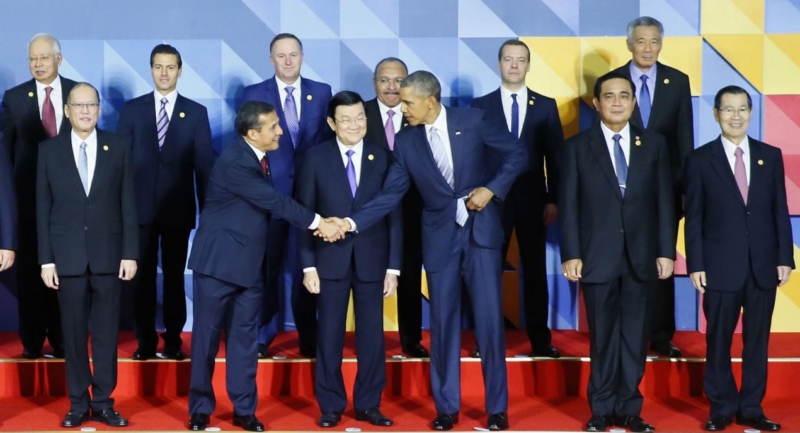Latin America Advisor
A Daily Publication of The Dialogue
What Promise Does APEC Hold for Latin America?

Peru is hosting the 28th APEC summit this year. How relevant is APEC today in light of geopolitical changes since its founding nearly three decades ago? How have the Trans-Pacific Partnership and other multilateral agreements affected its mandate? What promise does participation in APEC hold for Latin American countries, only three of which are currently members? How might China’s economic turmoil and fallout in emerging markets globally affect the APEC summit’s agenda this year?
Carlos Casanova, economist at BBVA Research in Hong Kong: “APEC continues to be one of the most important regional forums in the Asia-Pacific region, accounting for roughly 60 percent of the world’s GDP, 50 percent of trade and 40 percent of its population. What we are observing now is a region heavily influenced, at least economically, by China. Not surprisingly, the Trans-Pacific Partnership (TPP), has been interpreted as a response to China’s dominance. And while the TPP arguably competes with APEC’s own Free Trade Area of the Asia-Pacific (FTAAP), which is broader in scope, this is by no means a zero-sum game. On the contrary, existing initiatives, including three bilateral FTAs between China and Latin America, could even facilitate the advancement of APEC’s mandate. In fact, it is highly likely that one of the main themes of the APEC summit will be exploring future links between ASEAN and the Pacific Alliance. For Peru and Chile, this is a no-brainer. China is their second and first trading partner, respectively. Both countries are important commodity exporters that have experienced steep increases in their dependency on China. China’s growth slowdown and economic rebalancing have exposed fragilities associated with this increased dependency, highlighting the importance of export diversification, an area where Asia-Pacific offers ample opportunity. But the scope of future APEC cooperation goes beyond trade. Most interesting in the context of the 28th APEC summit is investments. China has spearheaded the creation of a number of initiatives that aim to boost infrastructure investments. These initiatives are not formally constrained to Asia, meaning Latin American countries, in particular the three APEC members, could attempt to attract some of these flows. APEC is not currently enlisting new economies, but it is highly likely that the other members of the Pacific Alliance would support Colombia if this changes. Finally, it is also likely that China will feature prominently at the summit. The recent turmoil in China’s financial markets had spillover effects across the world, proving that the country has gone from being a regional superpower to playing a more dominant global role.”
Margaret Myers, director of the China and Latin America program at the Inter-American Dialogue: “APEC’s efforts to leverage the growing economic interdependence of the Asia-Pacific region have been overshadowed in recent years by U.S. and Chinese visions for regional integration. In the trade realm, the United States has promoted the Trans-Pacific Partnership (which excludes China, for the time being) while China backed the Regional Comprehensive Economic Partnership (which excludes the United States). But APEC is hardly irrelevant. In addition to efforts to facilitate regional business, the forum actively promotes the Free Trade Area of the Asia-Pacific (FTAAP), which seeks to further regional integration by building on the TPP and RCEP. A collective strategic study of the FTAAP is due at the November summit in Lima. Negotiation of a FTAAP would be no small feat. Chinese and U.S. approaches to trade integration, as embodied by the TPP and RCEP, are very distinct. But further elimination of Asia-Pacific trade barriers will be increasingly critical for the region, especially as growth slows in China. Further regional integration can be facilitated by improved U.S.-Chinese cooperation on trade and investment. The United States and China have already decided to expand the list of tariff-free information and communications technology products. And United States-China Bilateral Investment Treaty negotiations are ongoing. Chinese inclusion in the Trade and International Services Agreement would be another promising development."
Harinder Kohli, president and CEO of the Centennial Group Latin America: “If one looks at the long-term fundamentals of the global economy, APEC remains as important to Latin America today, if not more so, than it was when APEC was first formed. Asia has been and is expected to remain the fastest-growing region of the world. It already boasts three of the four largest economies of the world in purchasing power parity (PPP) terms: China, India and Japan, with the United States as the second-largest. Asia as a whole generates more than 40 percent of global GDP. By 2050, it is expected to account for over half of the world GDP. It is hungry for what Latin America has in abundance: mineral resources and agriculture products. China, Japan and even India have surplus capital that Latin America can use. Geographically, Latin America is well located to sharply increase trade and investment relations with Asia. The recent ‘slowdown’ in China still means a growth rate of about 6 percent in the next few years. As the world’s second-largest economy, it will still be the largest contributor to the growth of the global economy, together with the United States and India for the next decade or so. The recent TPP agreement underlines the importance of closer economic relations across the Pacific basin. This trade agreement complements APEC, which is a political body and does not substitute it in any way. What is needed is for more Latin American countries to join APEC and for additional countries (particularly from Mercosur) to find a way to benefit from the TPP.”
The Latin America Advisor features Q&A from leaders in politics, economics, and finance every business day. It is available to members of the Dialogue's Corporate Program and others by subscription.



















